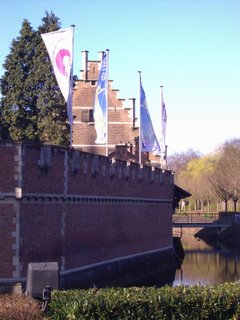 Reading the history, I discovered that there has been a moated, fortified farmstead on the site of the castle since the 13th century. It was called Hootvonder or Hooftvunder and probably defended a wooden bridge on Grote Schijn.
Reading the history, I discovered that there has been a moated, fortified farmstead on the site of the castle since the 13th century. It was called Hootvonder or Hooftvunder and probably defended a wooden bridge on Grote Schijn.In 1524 Gerard Sterck, a merchant, banker and secret counsellor of Emperor Charles V, bought it and built the castle Hooftvunder on the site of the farmhouse. The name later changed to Sterckshof to honour him.
Antwerpen fell to the Catholic Spanish in 16th century and although the castle suffered, it was never completely destroyed. Sterckshof's next owner was City Penionary, Jacob Edelheer and he used it as his city residence, filling it with art and scientific collections. It was inherited by his nephew who died childless and the castle was neglected as heirs fought over possession.
In 1693, the Lier Jesuits were the owners until they disbanded and the castle was auctioned off to Jan Baptist Cogels, a banker, who added the property to the Ter Rivieren Estate.
 The Province of Antwerpen bought Rivierenhof Park in 1921, with Sterckshof and nearby farmstead Sterckshoeve. By then, all that was left was a front extension of one floor with a turret, the entry gate and some rickety old buildings in the back.
The Province of Antwerpen bought Rivierenhof Park in 1921, with Sterckshof and nearby farmstead Sterckshoeve. By then, all that was left was a front extension of one floor with a turret, the entry gate and some rickety old buildings in the back. In 1922 architect J. A. Van der Gucht drew up the plans for a reconstruction, and in 1938, Sterckshof was opened to the public.
Sterckshof Silver Museum has taken on various guises over time until today when it is simply the Sterckshof Silver museum.
No comments:
Post a Comment